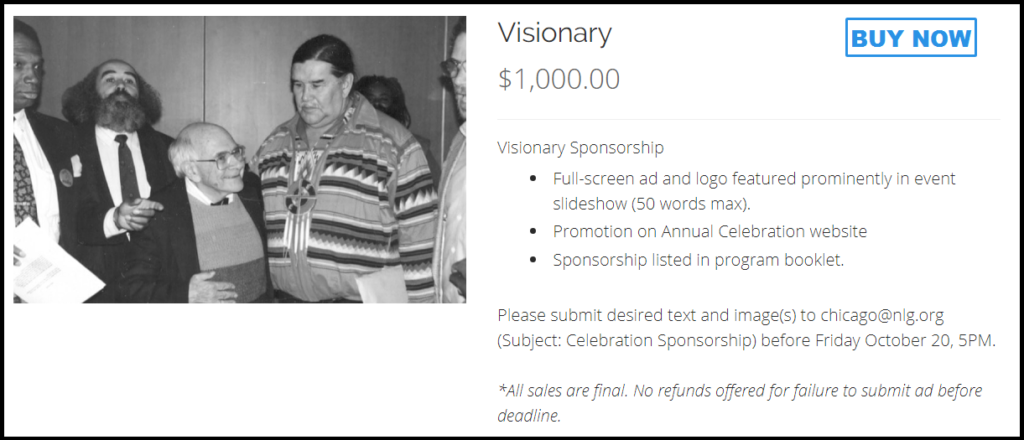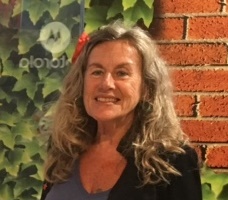
I moved to New York City to work as the first NLG law student organizer right out of law school, in June 1967. We argued that law students and lawyers could and should be part of the Movement, as well as legal defenders of the movements: struggles against the imperialist war against Vietnam, against the draft and military injustice, in support of the Black Liberation movement including political prisoners, SNCC and the Black Panther Party. We mobilized legal support for mass arrests at the Pentagon, demonstrations against Dean Rusk and Robert McNamara, GI’s returning their medals, the demands of Black Student Unions for African American history, culture, faculty and open enrollment, for an end to secret university war-releated research and their occupation of neighboring Black communities. We urged support for living wages for university staff and employees, and the rights of Black workers in DRUM. As I travelled to law schools across the country, law students eagerly establish NLG chapters to focus their work, and the NLG took root among radical lawyers and flourished.
After a decade as a federal fugitive on the FBI’s Ten Most Wanted list I was subpoenaed and called before a federal grand jury investigating the Brinks robbery in Manhattan in 1982. Two of the persons charged in the Brinks robbery were Kathy Boudin and David Gilbert. Due to their imprisonment, their 14 month-old son, Chesa Boudin joined our family as our third son, and always visited and maintained his close relationships with his biological parents, Kathy and David. The narrative below tells that story.
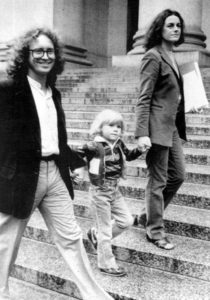
NLG Chi Proud to Present NextGen Award to #ExpandSanctuary Campaign
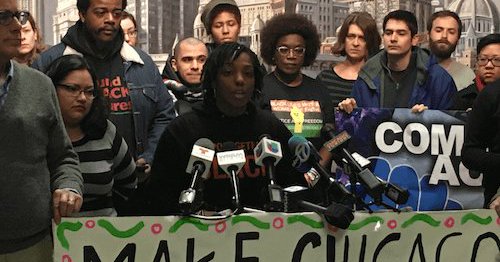
The #ExpandSanctuary Campaign is the joint venture of Mijente, BYP100, and OCAD. These three Black, Latinx, and migrant organizations came together in the wake of Donald Trump’s attack on “sanctuary” cities to push Chicago to stand in defiance of the President, defend the constitution, and promote policies that offer real safety to all residents. Their campaign is focused on four major goals:
- The decriminalization and alternative processing of crimes of survival, DUIs disproportionately policed in Black and Latinx neighborhoods, incidents at schools, drug related offenses, and more.
- Elimination of the flawed gang database.
- Reallocation of city resources from law enforcement to community institutions that provide long-term safety such as schools, clinics, and hospitals.
- Amendments to the Welcoming City ordinance to prevent collusion with federal deportation agents.
For another overview of the #ExpandSanctuary Campaign, you can watch this video with Tania Unzueta, the Legal and Policy Director for Mijente; and Janaé Bonsu, National Public Policy Chair of BYP100.
Expand Sanctuary from Sensitive Visuals on Vimeo.
Mijente is a new hub for social justice organizing both online and on the ground. They are meant to be the political home for Latinx and Chicanx people, helping develop the next generation of leadership for social change. The folks behind Mijente understand that in order to dismantle systems of oppression, Latinx leaders, advocates, organizers, cultural workers, media-makers, writers and theorists must come together to make the culture and policy changes their community needs.
Organized Communities Against Deportations (OCAD) is a community based organization in Illinois that organizes against unfair and inhumane immigration enforcement practices that impact immigrant communities. We fight case by case, person by person, at the same time that we work to change the implementation and enforcement practices that criminalize our community.
BYP100 is an activist member-based organization of Black 18-35 year olds, dedicated to creating justice and freedom for all Black people. They do this by building a collective focused on transformative leadership development, direct action organizing, advocacy and education using a Black queer feminist lens. Their work includes training young black activists in organizing and tactics, mobilizing young black leaders on issues of dismantling the prison industrial complex and securing LGBT and women’s rights, and running campaigns against the criminalization of Black youth, racial profiling, and police brutality.
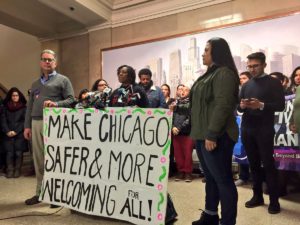
The #ExpandSanctuary Campaign was launched in Chicago in a press conference on January 26, in which Mijente, OCAD and BYP100 called on Mayor Rahm Emanuel to do more to committing to keeping Chicago a sanctuary city.
Since then, the campaign has also highlighted the effects of the gang database on Black and Brown residents of Chicago. In the case of Luis Vicente Pedrote-Salinas, his lawyers say he is not and never has been a gang member, but was falsely labeled as one after being arrested six years ago for allegedly having an unopened can of beer in his truck. Pedrote would qualify for DACA were he not erroneously listed in the database. To read more on the case, check out:
Chicago Sun Times: Unopened beer can, gang database errors fuel deportation case
Chicago Tribune: Immigrant sues Chicago, police for placing his name in gang database
On October 10, the #ExpandSanctuary Campaign, held an action against the proposed $95 million police academy by blocking a section of Randolph Street with three life-size representations of statistics that show how Chicago and Mayor Emanuel have failed to live up to the claim of being a “Sanctuary” city.
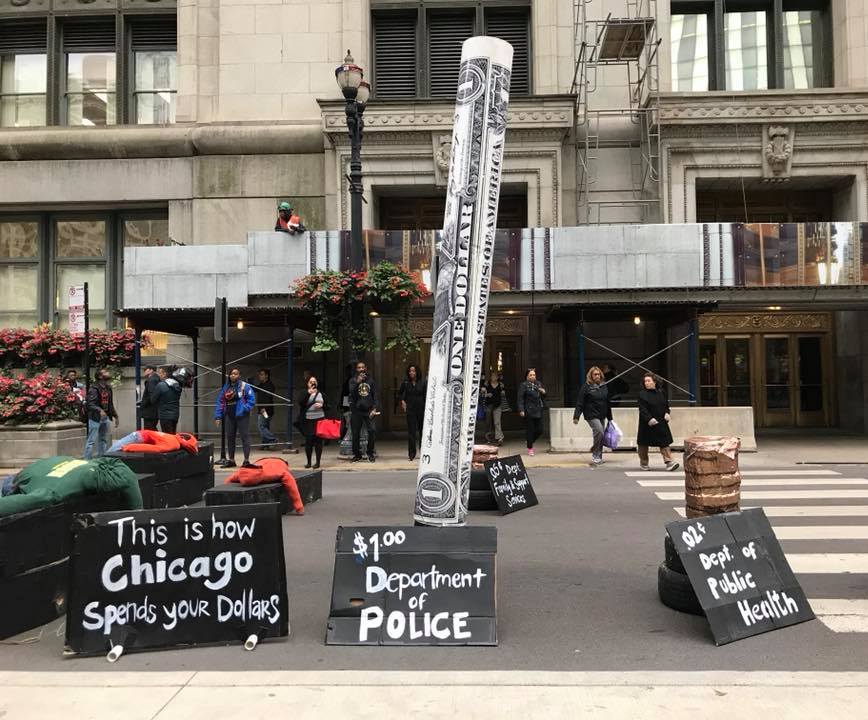
A bar graph that shows that for every dollar that the City of Chicago has allocated to the Police Department for 2017, there are 12 cents for the Department of Planning and Development, 2 cents for the Department of Public Health and 5 cents for the Department of Family and Support Services. To put this in context, the City of Chicago spends close to 40% of its budget on the Policing its residents, in addition to the $52 million that was paid by taxpayers for police misconduct in fees and fines in 2016.
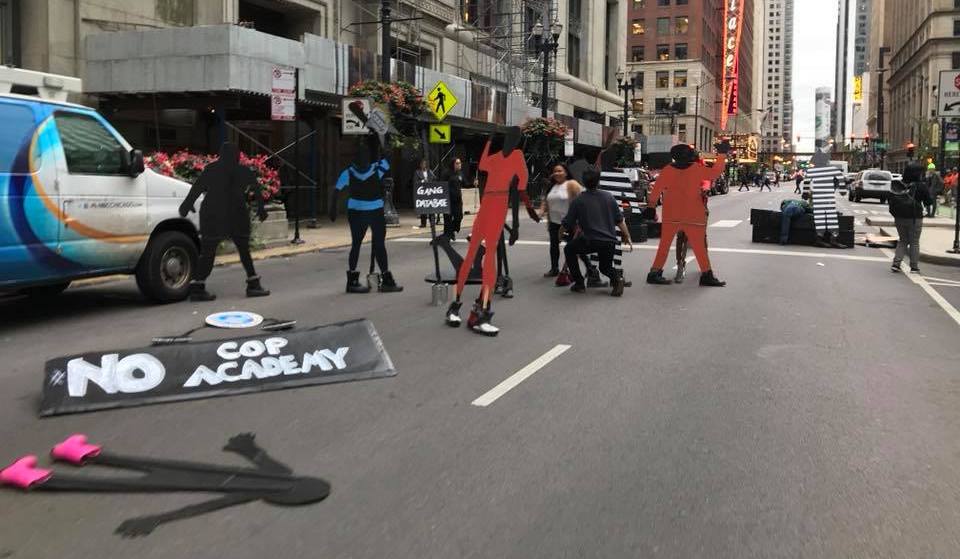
A series of silhouettes that show that when a police officer designates someone as a potential gang member — without any due process or judicial review, as currently happens in Chicago — the effects can include incarceration, unemployment, and in the case of immigrants, could mean deportation. An initial analysis of the CPD Strategic Subject List (SSL) reads that of those marked as “gang affiliated” 95% are Black or Latinx, and 97% are men.
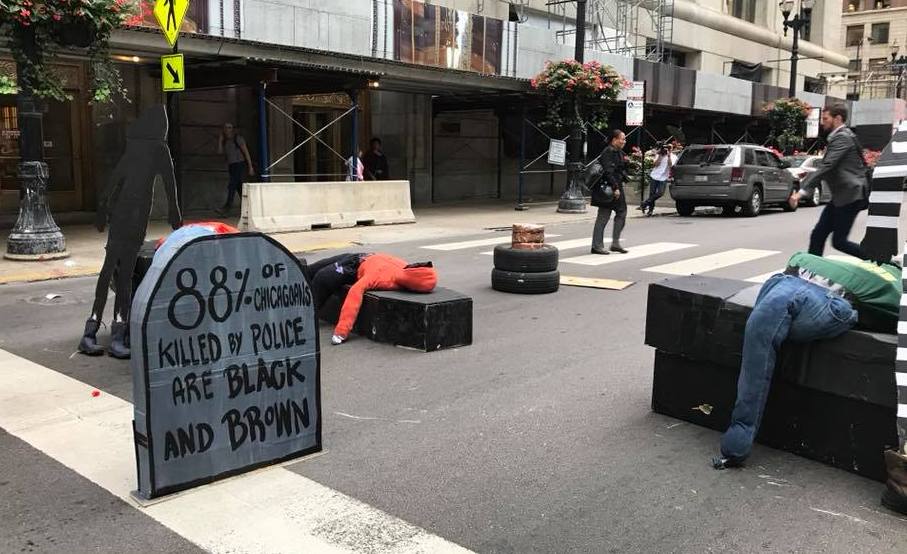
A series of coffins and bodies to represent that 88% of the people hit or killed by the Chicago police between 2008 and 2015 are Black or brown.
The National Lawyers Guild is proud to be presenting the NextGen award to the #ExpandSanctuary campaign. Mijente, BYP100, and OCAD represent some of the most innovative and outstanding organizing in Chicago.
For our 80th Anniversary, show your support for the Guild by buying a ticket!
We Remember Arthur Kinoy – Celebrating 80 Years of Law for the People

Arthur Kinoy (center)
Arthur Kinoy (September 20, 1920 – September 19, 2003), was an American attorney and progressive civil rights leader. He served as a professor of law at the Rutgers School of Law–Newark from 1964 to 1991.
Kinoy took an active part in the defense of Ethel and Julius Rosenberg from 1951, who were convicted of atomic espionage. During the 1950s and 1960s, Kinoy represented persons called to hearings of the House Committee on Un-American Activities; in 1966 he was officially removed from a hearing by Senator Eastland, its chair, and subsequently convicted of disorderly conduct. In 1968, the U.S. Court of Appeals overturned the conviction. In 1964, at the height of the Civil Rights Movement activities in the South to end disenfranchisement and segregation, he participated in a conference sponsored by the National Lawyers Guild’s Committee for Legal Assistance in the South. It briefed attorneys on legal problems confronting civil rights demonstrators in Mississippi, where state and local governments resisted change. He and his partner, William Kunstler, were two of the most prominent attorneys during the 1960s to handle civil rights cases in the South.
Mr. Kinoy was involved in a number of landmark legal verdicts. In 1965, he successfully argued the case of Dombrowski v. Pfister before the Supreme Court, which empowered federal district court judges to stop enforcement of laws that had ‘a chilling effect’ on free speech. In a subsequent case, Dombrowski v. Senator Eastland, he established that the Counsel of the Senate Internal Security Committee was not immune from suits for violations of citizens’ civil rights. In 1972, the Supreme Court upheld his contention that President Richard M. Nixon had no ‘inherent power’ to wiretap domestic political organizations.
You can also watch an excellent interview of Kinoy, hosted by the Film Archive.

We honor and remember Arthur Kinoy for his visionary leadership. His stalwart defense of free speech, and his commitment to the rights of oppressed people, is an inspiration to all of us in the Guild. We thank him for passing on the torch to a whole new generation of people’s lawyers during his years as a professor.
With your help, we can build the next generation of people’s lawyers. For our 80th Anniversary, show your support for the Guild by buying a ticket and becoming a sponsor!
NLG Lawyers Fight Against the Prison Industrial Complex for Over 46 Years
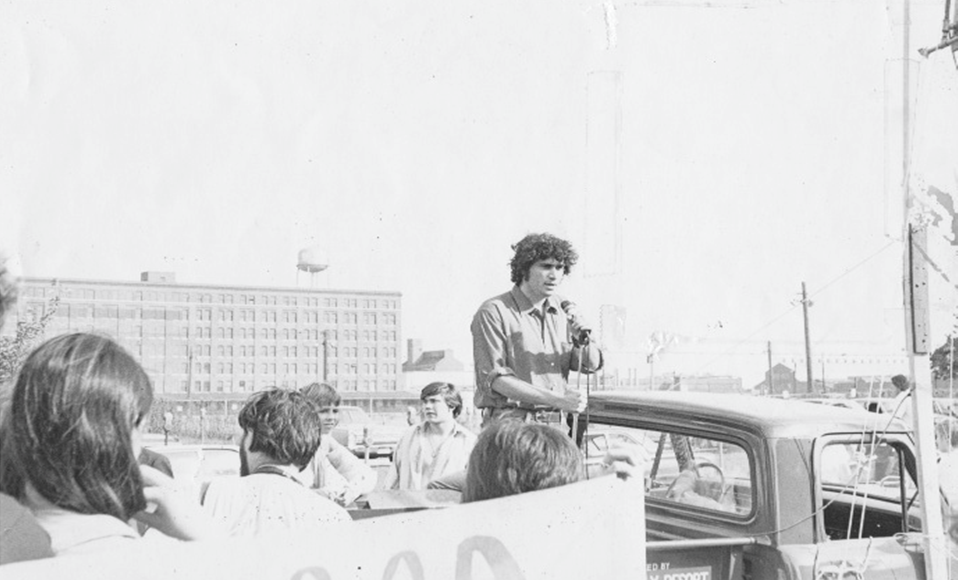
Jeff Haas Speaking at Attica Rally Cook County Jail 1971
After returning from the 1971 Attica Prison Uprising in upstate New York, Jeff Haas spoke at a rally at the Cook County Jail to pass on the stories of the men inside. Their message was a call to prisoners to stand up against brutality and inhumane conditions, and for people on the outside to support their struggle.
You can read an article about the rally published at the time by the Notre Dame & St. Mary’s Observer.
PLO lawyers took the lead in the legal representation of the Attica prisoners. Following the suppression of the uprising and the killing by law enforcement of 39 guards and prisoners, the PLO lawyers were some of the first outsiders to enter the prison. They worked on several cases in which prisoners sought relief from maltreatment and abuse by guards following the riot. PLO lawyers joined with other attorneys to file a civil case for damages on behalf of the prisoners and against the state correctional system. This case continued for years, and eventually resulted in a settlement for the prisoners of $12 million.
On October 14th, last year, Loyola NLG, the Uptown People’s Law Center, and People’s Law Office hosted a panel/discussion about Attica and the prison strike of Summer 2016.
https://nlgchicago.org/blog/loyola-nlg-the-attica-prison-rebellion-its-legacy-and-the-prison-struggle-today/
For our 80th Anniversary, show your support for the Guild by buying a ticket and becoming a sponsor!
NLG Chicago Condemns Trump Decision to Terminate DACA
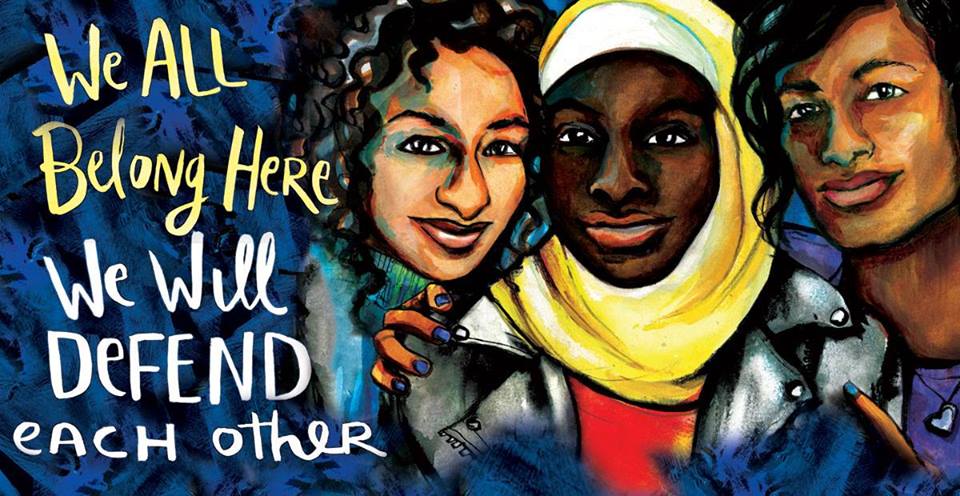
The National Lawyers’ Guild of Chicago stands with all immigrants and for immigrant rights.
We stand in solidarity with over 800,000 DACA recipients in the United States in calling for the Trump administration and our congress to withdraw all threats to remove the current protections afforded these young people and instead to move forward in developing an immediate path to citizenship for these Americans. Under the current “phase out” of the DACA protections, anyone whose status expires by March 5, 2018, has until October 5, 2017 to apply for a new permit. This means that almost a quarter of all DACA recipients must reapply.
As lawsuits across the US have stated, including the one joined by the Illinois Attorney General filed on September 7, 2017, the DACA phase-out demonstrates a racial animus. It violates the Equal Protection Clause of the Constitution as well as the Due Process Clause. Devoid of any attempt to create a better and more sustainable way forward for all DACA recipients, the phase-out puts hundreds of thousands of people in danger. This action yet again demonstrates the structural racism and pervasive inequality that dehumanizes, threatens, and degrades members of our community. This inhumane, racist, and illegal action is just one in a long line of recent actions by the administration against immigrants. As movement lawyers, we cannot and will not watch these actions tear apart our communities.
Due to the impossible timeline and obscene expense placed on thousands of DACA recipients to renew their DACA card in the coming weeks, the NLG urges our membership to act now. Please consider volunteering with The Resurrection Project, the National Immigrant Justice Center, or the ICIRR, or donating to You Caring – an organization that helps people pay the $495 filing fee required by the US government.
Finally, NLG urges you to consider joining the NLG Legal Observers. Our Legal Observers, by documenting arrests made at protests, support those protesting this administration’s ongoing war on marginalized communities.
NLG Mobilizes Legal Support as St. Louis Police Make Brutal Mass Arrests Following Stockley Acquittal
September 21, 2017
Contact: King Downing, Mass Defense Director
massdef@nlg.org
Tasha Moro, Communications Director
communications@nlg.org | 212-679-5100, ext. 15
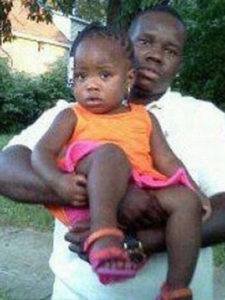 ST. LOUIS—The NLG is on the ground in St. Louis, MO coordinating legal support following thousands-strong protests that have emerged since the Friday acquittal of former St. Louis Metropolitan Police (STLMPD) Officer Jason Stockley, in the 2011 murder of Anthony Lamar Smith. Using tactics reminiscent of Ferguson, STLMPD have arrested at least 170 people— including protesters, three Legal Observers, journalists, and bystanders—since demonstrations began Friday. A few have been released on their own recognizance, and a number are being charged with felonies. The St. Louis NLG Chapter has been leading legal support efforts, operating a legal support hotline and St. Louis Legal Fund, and providing Legal Observers and defense attorneys with the help of ArchCity Defenders and ACLU of Missouri.
ST. LOUIS—The NLG is on the ground in St. Louis, MO coordinating legal support following thousands-strong protests that have emerged since the Friday acquittal of former St. Louis Metropolitan Police (STLMPD) Officer Jason Stockley, in the 2011 murder of Anthony Lamar Smith. Using tactics reminiscent of Ferguson, STLMPD have arrested at least 170 people— including protesters, three Legal Observers, journalists, and bystanders—since demonstrations began Friday. A few have been released on their own recognizance, and a number are being charged with felonies. The St. Louis NLG Chapter has been leading legal support efforts, operating a legal support hotline and St. Louis Legal Fund, and providing Legal Observers and defense attorneys with the help of ArchCity Defenders and ACLU of Missouri.
The community is charging that STLMPD violated protesters’ rights—arresting people en masse without probable cause—and used excessive force during arrests, with indiscriminate and inappropriate use of tear gas and chemical projectiles.
“These arrests were more like a general ‘sweep the streets’ action than arrests for criminal violations,” said Steven Hoffmann, member of the St. Louis NLG Chapter. “Law enforcement is being carried out in a way that doesn’t protect public safety, but endangers it.”
“The police took people trying to get into their houses, tourists, people out with their children, knocking people off their bicycles, reporters, Legal Observers,” said Kat “Mama Kat” Daniels, a classically trained chef who has been cooking for and feeding protesters. “Thank you, Metropolitan Police Department—what you did was gain us more support. The people are now seeing what we’ve been saying for a long time.”
Disturbing footage of STLMPD tactics immediately circulated on social media. On Friday, police trampled an elderly woman who had been attempting to disperse before arresting her for “interference.” Sundaynight, STLMPD “kettled”—a tactic in which law enforcement encircles a large group before arresting them for failure to disperse—about 100 people, while attacking them with chemical weapons. Shortly thereafter, a group of police chanted, “Whose streets? Our streets!” in a chilling display of intimidation.
This brutal treatment of anti-racist protesters by law enforcement in St. Louis stands in stark contrast to the laissez-faire attitude of Charlottesville PD toward armed, white supremacist demonstrators during the deadly “Unite the Right” rally last month. Such hypocrisy that casts doubt over the violent intentions of the white supremacist far right, while criminalizing and demonizing the anti-racists who resist them, fuels the toxic “many sides” myth championed by President Trump and his following. Even evidence as blatant as Stockley’s declaration that he was “going to kill this mother****r” before the shooting was not enough to convince Judge Timothy Wilson of the officer’s intent to kill. It is this systemic racism that permeates our institutions and routinely fails people of color like Anthony Lamar Smith.
The National Lawyers Guild was formed in 1937 as the nation’s first racially integrated bar association to advocate for the protection of constitutional, human and civil rights.
Photo: Anthony Lamar Smith with his daughter in a family photo.
- « Previous Page
- 1
- 2
- 3
- 4
- 5
- …
- 17
- Next Page »


